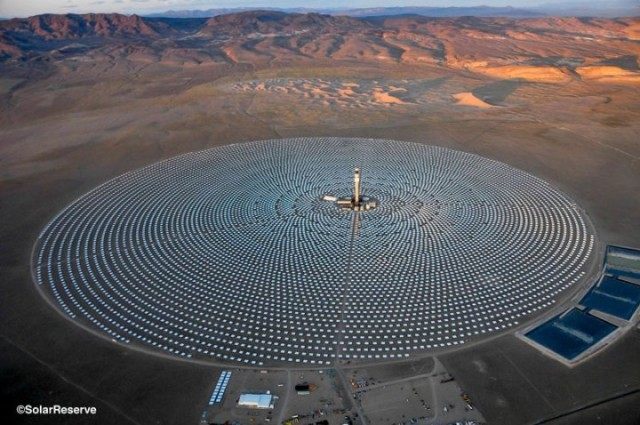Supporters of renewable energies hope that new advances in solar technology will figuratively set the world on fire, but for hundreds of birds in Nevada last month, that scenario became a literal reality. Nearly 130 birds were set alight mid-flight during tests for the new 110 megawatt solar array plant in Tonopah, Nevada. (h/t Watts Up With That)
The Crescent Dunes Solar Energy Project uses 17,500 heliostat mirrors, each the size of a garage door, to direct sunlight to a central tower rising 1,200 feet above ground level. The combined energy is transferred to molten salt held in the tower, which is circulated and produces steam to generate electricity. Excess heat is stored in the salt, allowing electricity to be generated for up to ten hours without sunlight.
“The Crescent Dunes Solar Energy Project will reduce the nation’s reliance on fossil energy supplies, producing enough solar energy in one year equivalent to about one-eighth of the total output of Hoover Dam,” announced the developers during the groundbreaking ceremony in 2011, according to Nature World News.
On January 14th, about a third of the plant was brought online for testing. Unfortunately, about two hours into the test biologists and engineers on site began to notice “streamers” – trails of smoke and steam caused by birds flying into the field of solar radiation. Any moisture on the birds was instantly vapourised, whilst some of the birds themselves burst into flames even as they flapped away. Nearly 130 birds were killed or injured during the test.
This isn’t the first time that the threat posed by solar arrays has been raised. The Ivanpah Solar Electric Generating System, located in the Mojave Desert, comprising 300,000 solar mirrors is more than fifteen times the size of the Crescent Dunes project. It produces a field of radiated solar energy so large that it causes one streamer every two minutes, according to investigators.
Federal wildlife officials have begun referring to the solar arrays as “mega traps” for wildlife, despite protestations by Ivanpah officials that the streamers are floating rubbish or insects straying within the field. But biologists believe the streamers are caused by a chain of reaction, as insects attracted by the tower’s bright light in turn attract bird species.
Researchers have called the number of bird deaths “significant”. The US Fish and Wildlife Service is awaiting a report on the number of bird deaths at Ivanpah for a full year of operation; the results of that report may impact the development of this technology at other sites in the United States and beyond.

COMMENTS
Please let us know if you're having issues with commenting.